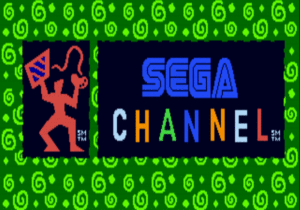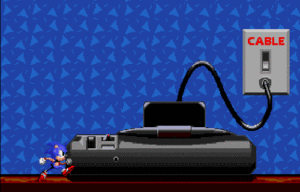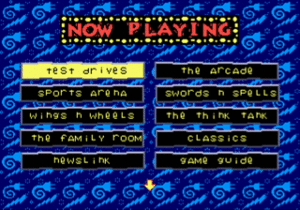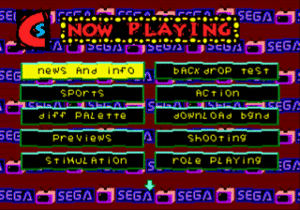This interview originally appeared in the May 1994 issue of the French game magazine, Mega Force. The interview was conducted by Andrew Burgess on April 11, 1994, with Sega of America’s Vice President of Programming and Sega Channel Program Director Michael Shorrock and Production Manager Ray MacFadden. They discussed the new Sega Channel and their expectations for its potential.
Originally, there was a twenty-year-old young American from Brooklyn, David Rosen. In 1954, residing in Tokyo, he launched a small import-export business between Japan and the U.S. What could be more banal up until then? In fact, the story of Sega (short for “Service Games”) really begins two years later, when dear David brought home what would become arcade machines, very popular with the American marines based in the Land of the Rising Sun. Not satisfied with the services offered, he decided to put into practice this personal reflection that has been verified many times since: “Only cutting-edge technologies create and win markets.” Would it be the same for the Sega Channel? Sneak peak.
What is the Sega Channel, chaine Sega in French by the polyglot Mr. Toubon? According to a recent press release, this American cable channel will be the first interactive television service, offering continuous 24-hour programs about video games. Each month, the homes equipped with a Mega Drive and cable network access will have, among other services, the possibility to play around 50 titles announced for the 16-bit console, distributed across 10 pre-defined categories. Andrew Burgess, our correspondent and permanent spy across the Atlantic, got an exclusive interview with two prominent members of Sega of America working currently on the Sega Channel project. Although it currently operates only in the U.S. within a small development framework, and though there is talk of it in France, it still exists only as a project.
Mega Force: Could you explain to us what the Sega Channel is?
Michael Shorrock: In short, this channel will allow the user to practice video games through cable, like when you play networked PC games through a modem, only we use the advanced technology of the cable network to arrive directly at the consumers’ homes as they play on their Mega Drive (Genesis in the U.S.). The broadcasting of these interactive products through television will be considered media of its own and we are fully ready to associate this technology with 16-bit games.
Mega Force: Is it true that Sega is working with multiple TV companies on the project?
 Michael Shorrock: Absolutely. The entire concept is under the direction of Doug Glenn, who is Sega’s Vice President of Business Development. He has spent the past two years traveling the territory to bring everyone around to the concept of the Sega Channel. On paper, however, the channel is equally owned by Sega, Time Warner Entertainment and Telecommunications (TCI). Of course, Sega’s two partners already have numerous interests in U.S. cable networks. Also, we are joined by several small associated companies working on a local scale on the cable networks of around a dozen states including Texas, Kansas, and Pennsylvania.
Michael Shorrock: Absolutely. The entire concept is under the direction of Doug Glenn, who is Sega’s Vice President of Business Development. He has spent the past two years traveling the territory to bring everyone around to the concept of the Sega Channel. On paper, however, the channel is equally owned by Sega, Time Warner Entertainment and Telecommunications (TCI). Of course, Sega’s two partners already have numerous interests in U.S. cable networks. Also, we are joined by several small associated companies working on a local scale on the cable networks of around a dozen states including Texas, Kansas, and Pennsylvania.
Mega Force: In reality, how will this work in consumers’ homes?
Michael Shorrock: The mode of operation will be close to that of a “normal” cable channel, such as HBO (Home Box Office, the equivalent of Canal + in terms of programming in our country). Without revealing too many details, since the final version of the project will only be announced after the conclusion of the current tests, I can still tell you that the price should be between $12-$20 monthly, with a planned installation cost of $50. When you subscribe, you will receive a small decoder the size of a Mega Drive cartridge to plug into your home console, normally connected to the television. The decoder will serve as a link to the cable network and the Sega Channel. After this, the interactive gaming space will be available to you.
Mega Force: What benefits will subscribers receive?
Ray MacFadden: 24-hour-a-day, non-stop programming with a choice of the 50 best Mega Drive games every month. We already predict a turnover of around 75% of the games market per month – the Mega Drive library has around 500 titles, to which around 150 titles are added per year – which gives us quite a bit of choice for the channel.
Michael Shorrock: By turning on your receiver, the BIOS menu will appear, from which you can access the games of the month, with information on the latest releases or current offers. Next, you can choose from 10 game categories: sports, arcade, simulation, role-playing, puzzle, family and educational games, the classics, and “test drives.” The test drives allow players to practice for 10 minutes on pre-release versions of games since a study showed that people like to be aware of future releases, especially when they have the opportunity to play them before anyone else. As for the other nine selections, the subscriber may choose between different titles such as Landstalker, Ranger X, Ecco, Fatal Fury, and many others.
Mega Force: And this is expected to arrive very soon?
Michael Shorrock: Beginning at the end of April, we will run tests on around a dozen potential markets across the country. Cities like Beaumont, Texas; Portland, Oregon; St. Louis, Missouri; and Cheyanne, Wyoming will be included. After that, we should be able to broadcast across the whole continent around September, if the results obtained are in line with our estimates. We may not, however, be too forward, as the production of the decoder is not at its full pace.
Mega Force: Will the project go beyond American borders?
Michael Shorrock: Sega has started setting up the system in Japan, and we hope that it will soon see the light of day in a country on the Old Continent such as Germany, France, or Great Britain, early in 1995. No matter the chosen destination, the Sega gaming and cable markets are strong and well-established enough for it to work. All that remains is to find the right partners for the project. In the long term. We are even considering entering consumer homes by satellite, which is possible in theory but not viable today.
Mega Force: Will the games be exactly the same on the Sega Channel as those available at retail, or will they be adapted in any way for cable?
Ray MacFadden: There won’t be any difference. The versions will be identical at retail and through cable.
Michael Shorrock: It’s all about the data and program compression technology that we’re going to use. By improving this technology, the product offered will undergo the same evolution. Soon, we plan to produce games exclusively for the channel, and why not add one or more one or more levels or new characters each month for a particular game, chosen beforehand? Yet another advantage for future subscribers…
Mega Force: As far as publishers and developers are concerned, what do they think of the project? Are they afraid of a potential drop in retail sales?
Ray MacFadden: Most publishers have been excited about the Sega Channel, and companies like U.S. Gold and Core Design in Europe are fully onboard with the concept. We have their approval to fully start tests in the territory. Obviously, economic questions have arisen, and some publishers prefer to wait for test results before joining worldwide, but globally, we believe there’s something in it for everyone.
Michael Shorrock: We believe that the Sega Channel should satisfy consumers and publishers alike. Subscribers will be able to play any of the games available each month, when and for as long as they want, for less than $20 per month, with the possibility of testing pre-release versions of the games, something unthinkable at your nearest Toys ‘R Us.
 Be aware, however, that all new titles will be available only three months after their release at retail or for rental, so as not to kill the market. In a way, the Sega Channel will be complementary since the games will benefit from wider exposure not only in terms of the Channel but also through exclusive special offers for subscribers. Finally, this will also allow for relaunching products considered to be “old,” and even increase their lifespan, a significant asset for publishers, who will also receive additional royalties for each available title. And small publishers with limited advertising/promotion budgets will thus have a medium at their disposal available for little cost.
Be aware, however, that all new titles will be available only three months after their release at retail or for rental, so as not to kill the market. In a way, the Sega Channel will be complementary since the games will benefit from wider exposure not only in terms of the Channel but also through exclusive special offers for subscribers. Finally, this will also allow for relaunching products considered to be “old,” and even increase their lifespan, a significant asset for publishers, who will also receive additional royalties for each available title. And small publishers with limited advertising/promotion budgets will thus have a medium at their disposal available for little cost.
Mega Force: All things considered, are you still very optimistic?
Michael Shorrock: How could we not be? Right now, the channel is being set up with only around 20 employees. Four are based in Redwood City, Sega’s “headquarters,” and take care of the production and scheduling side. The other 16 people work in New York on the marketing side of things, but we are prepared to increase this number if necessary. Together with Time Warner TCI and the six others associated with the project, we can already offer the channel to around 22 million potential consumers with expectations to reach 60 million people cabled in the U.S. We know that 10-12% of households subscribing to cable own a Mega Drive. Therefore, even with limited market penetration, as a start, we should reach a substantial number of consumers.
Mega Force: Good luck and thank you.
Postscript: According to an estimate made by the renowned New York consulting firm Goldman Sachs, the Sega Channel should achieve a turnover of $33 million after three years of operation.
Sega-16 would like to thank Prof. Bernice Rivera and Augitesoul for their help translating this article.



Recent Comments